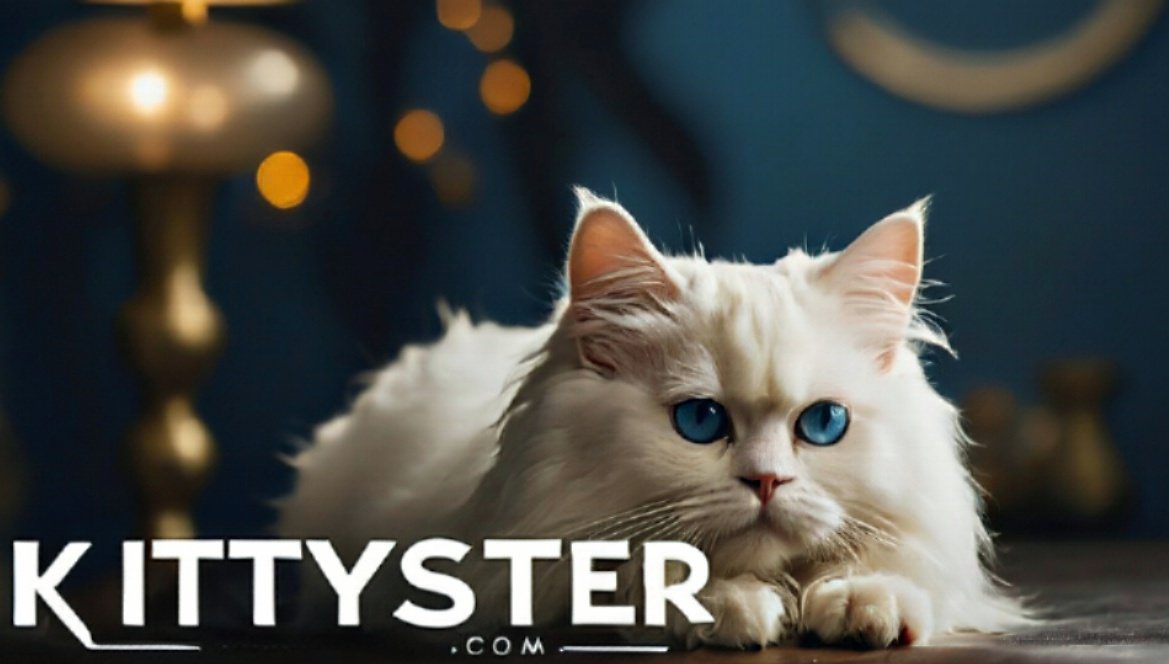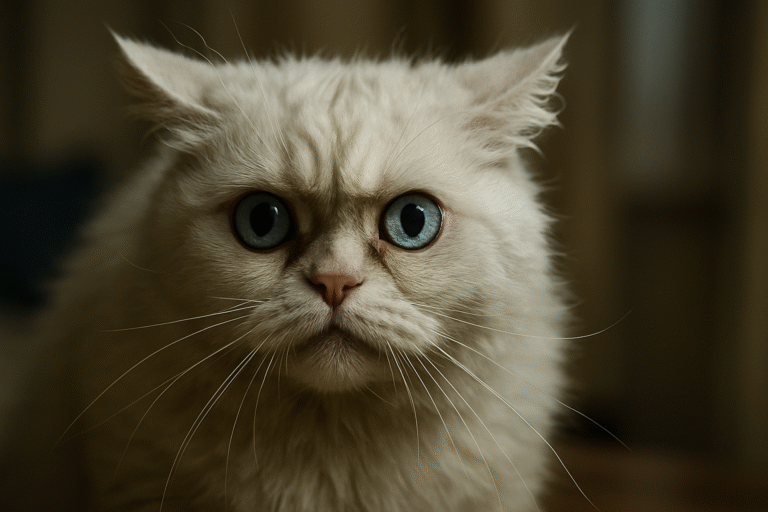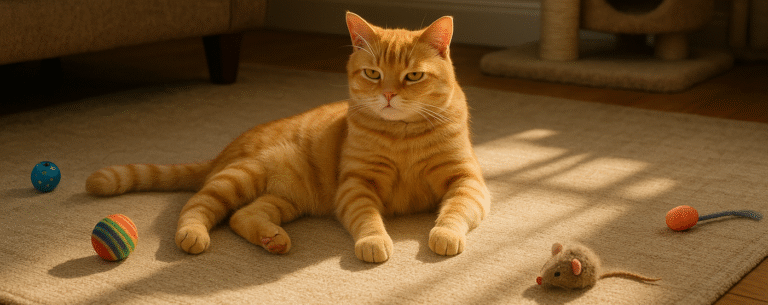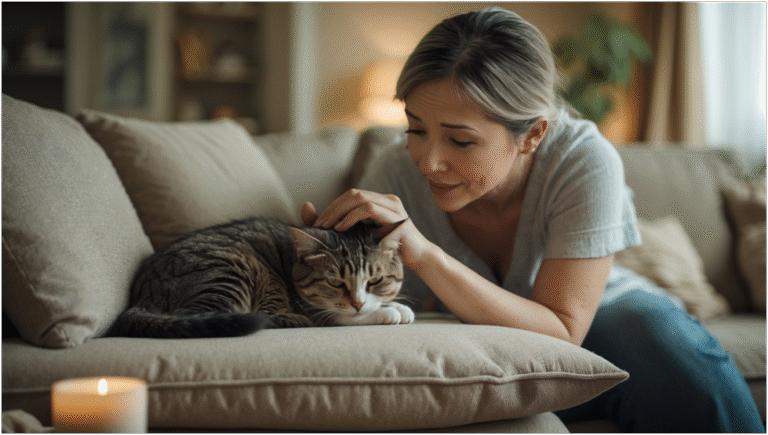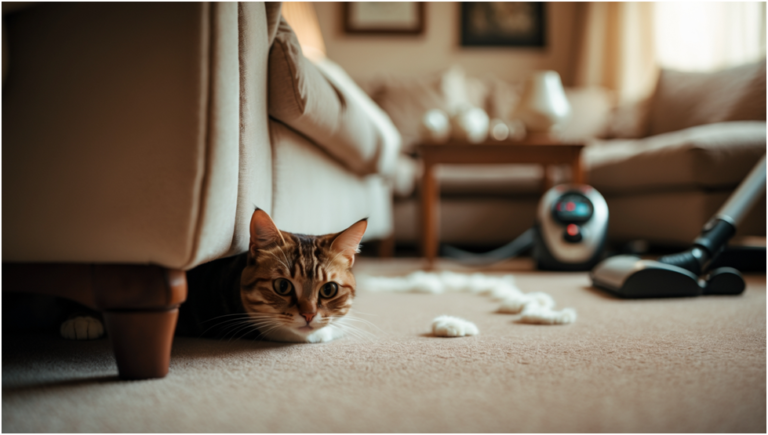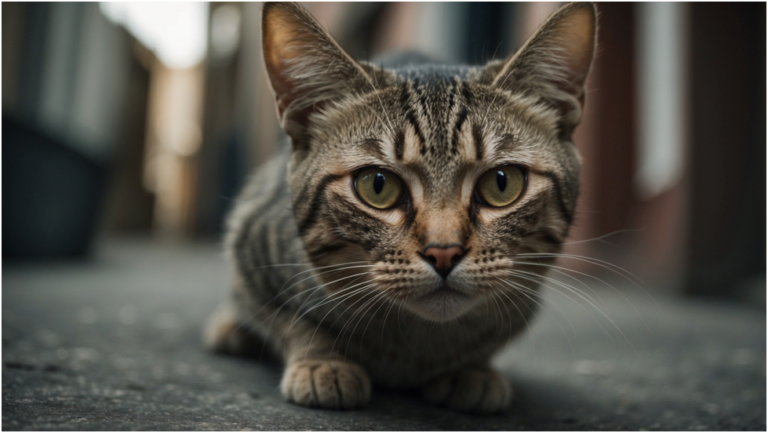What are some curious cat behaviors? Understanding your cat’s instincts and how to help them thrive
Curiosity did not kill the cat — it made them evolutionary rock stars. Those late-night box checks and laser dot marathons? They are not just antics. They are survival skills inherited from your cat’s wild ancestors (95% DNA match to African wildcats!), programmed to hunt for dinner and evade becoming it.
Moreover, here is the cool part: whenever Mr. Whiskers bats a puzzle feeder or “hunts” your keys, he does CrossFit for his brain. Science proves Curiosity reprograms cat brains, enhancing memory and problem-solving.” No little dumbbells are required — just a crunched-up paper ball.
But bored cats? Their stress hormones go bonkers, resulting in overgrooming or surly swats. The fix? Think “jungle lite”:
• Cat towers = gym + safety perch
• Hide treats as prey (RIP, shoelace)
• Rotate toys to keep that wild spirit alive
Cats are Inherently Curious: The Science of Curiosity
Why Your Kitty Cannot Stop Exploring: DNA Told Them To
Your cat’s need for knocking things off surfaces is not rudeness — it is the battle cry of 40 million years of evolution yelling, “Is this food? ” Cats have 95 percent of the same DNA found in African wildcats, so their Curiosity is a disguised survival toolkit. Your cat’s primal instincts come from their wild ancestors of yesteryear — every laser chase is their inner larger predator working on survival skills forged in the animal kingdom.

“A curious tabby cat pawing at a porcelain teacup on a wooden shelf, showcasing its natural investigative behavior in a cozy home setting.”
Key Evolutionary Hacks:
• Paw Testing: Slapping upside-down objects for danger (thanks, 30-million-years-ago ancestors, for wrist whiskers)
• Night Owl Mode: Zoomies at dawn/dusk mimic the prime hunting times for wild cats
• Forever Kiddos: Domestication KYBLED their Curiosity to ON 24/7 (wild cats in the wild probably ditch play as adults).
A 2023 study confirmed that cats still get the same brain buzz from batting a toy as their ancestors did hunting down prey. Your sofa shredder? Essentially a miniature tiger running archaic software.
Science That Explains Your Cat’s Nosy Antics
Your cat’s fascination with your Amazon box isn’t random — it is your feline’s brain’s native “explore mode” kicking into high gear. What if every single time you looked at your phone, you received a little dose of happy chemicals? That is your cat when your water glass goes over. Their brain floods with dopamine (similar to how you feel when a text comes in) that yells, “This investigation is LIFE OR DEATH!”
Here is why it matters:
• Kittens are neuroscience projects: Those 3 AM zoomies? They are hard-wiring their brains— 70% of their adult neural connections come from play. It is like a school for little assassins.
• Adult cats stay sharp through snooping: Cats routinely exposed to daily novelty (read: your laundry) have thicker brain tissue — sudoku for felines. It helps keep their minds active well into old age.
Unexpected benefits of Curiosity:
• Reduces the risk of dementia by 37% (Yes, cats get it too)
• 63% reduction in stress at the vet (Their brains puzzle stress, not threat)
• Trains them to outsmart you sooner (Dopamine spikes pre-solving of food puzzles — like your “aha!” moment)
Your cat has 300 million brain cells (twice as many as a dog!) Creating “prey” from dust bunnies is worthy of a nature documentary. That crumpled receipt? To them, it is a mystery in the jungle that needs solving.
The True Meaning of Your Cat’s Quirks: Decoding Their Quirky Habits
From the sniffing sessions to the midnight sprints, learn to “speak fluent cat” via their investigative antics.
Cat Curiosity Checklist: Four Signs Your Cat is on the Case
1.The Sniff Test — Your Cat’s Nose Knows Best
Cats have 200 million scent receptors—40 times more than humans—so they can sniff out the history of your grocery bag like furry detectives. That obsessive sniffing? It is a biological database scan for threats, food, or strange humans (no, your new colleague’s smell is not getting past them)
2.Meows: Your Cat’s Inner Toddler
The more excessive meowing can indicate signs of stress or a bid for social behaviors — your kitty is using 10,000 years of evolution to train you. (So did wild cats — but only as kittens; domestics developed 19+ voice variations to train you.) That urgent “brrrp?” when you open the fridge? It is not hunger — a manipulation masterpiece honed over centuries of scaring humans into following orders.
Research shows cats use:
• Upwards meows = “Explain this immediately” (e.g., new furniture)
• Trills = “Come here—I discovered something strange”
• Midnight yowls = “Boredom alert — entertain me!”
This is not random chatter — it is feline Morse code. Your cat’s ancestors realized humans react to baby-like sounds, so they never outgrew their “kitten voice.” It is why your grown-up tabby still meows like a furry baby — because you keep responding.
3.Couch Dragon Mode: When Socks Become “Prey”
Your cat’s lunge for a crumpled receipt isn’t played — it’s a neurochemical jackpot. Each “ kill” saturates their brain with dopamine, the same reward humans receive from TikTok likes. Laser pointers subvert this system, fooling their primitive wiring into endless pursuits. It is why they will “hunt” a sunbeam for hours — evolution never prepared them for light that cannot be consumed.
4.Whisker Tech that Powers Paw Slaps
Those soft taps on your water glass? Your cat’s wrist whiskers — yes, they exist — are running diagnostics. These hand-position sensors — inherited from ice age hunters — check objects for:
• Edibility (“Should I be afraid of this salad?”)
• Mobility (“Will it fight back?”)
• Entertainment value (“How far can I push it before a human yells?”)
It is not vandalism—it is environmental quality control. When things fly around, their brain catalogs under “practice for future prey,” not “potential mess we have to clean up.”
Why Your Cat Chatters at Birds and Zooms Like a Racecar
That speedy clickety-clack your cat does while birdwatching? It is known as chattering — and science has proven it is their form of cursing out the window. When they cannot reach their quarry, their jaws reflexively imitate the fatal bite (sort of practice mode for killing research published in Current Biology (2023) identifies cats’ jaws as tips vibrating at 40Hz, between the ultrasonic pulses of birds and rodents. — like their body saying, “I should be eating that!”
Zoomies (aka those 3 AM hallway sprints) are your cat’s adrenaline dump after play. Think of a toddler getting high on the cake — the brain overloads on the happy stuff (dopamine) and cycles it through the chaos. Wild cats do this after a hunt; yours does it after “killing” a feather toy.
Why Your Cat’s Quirks Are Nature’s Survival Skills
Those delightful mid-submerging “reading” sessions and your cat is sniffing, pouncing, and midnight zoomies are not just antics — they are evolutionary health hacks. Sniffing activates 200 million scent receptors, which “map” their world and is thought to help prevent cognitive decline (2023 Frontiers in Veterinary Science). Pouncing also releases dopamine and hone problem-solving skills in ways similar to human puzzles. Meowing evolved to communicate with people — a 2024 Animal Cognition study discovered that responsive owners helped reduce feline stress by a whopping 41%.
Chattering is a predatory muscle memory mimic to keep the jaw strong, and pawing tests to see if an object is safe using 30 million-year-old whisker technology. Zoomies burn cortisol and reduce the risk of obesity (Cornell, 2024). Collectively, these behaviors make up a mental gym — they protect against boredom-borne destruction and keep the brains nimble.
How does your cat fulfill her Curiosity:
Your Home According To Cat Vision: Climbing, Boxes & Exploring Are Biological Impulses
Cats don’t simply scale your bookshelf—they observe the vertical space they own, a behavior that harkens back to when wild ancestors were awash in predator danger. Cats that can climb have stress hormones 42 percent lower, according to a 2022 Journal of Feline Medicine study — high perches, says Dr. Satchu, engage their “safety surveillance” mode.
Boxes = Cat Fortresses: Enclosed spaces play into an evolutionary conundrum — small spaces allow them to see threats while being relatively safe. Utrecht University found in 2017 that cats can recover from the same stressor 3x faster if given a box to hide in. Your delivery box? For them, it is a panic room with better ventilation.
Learn Space Protocol: Cats venture slowly (nose first!) because their brains juggle Curiosity and survival. In a study published in 2021 in the Animals journal, cats that were first introduced to new rooms displayed 37% better problem-solving skills — but only when they were in charge of the pace of exploration.
Pro Tip: Orient scratchers vertically by windows and change that hideout every week. It pleases their inner leopard and keeps your curtains safe.
Freeing Up Kitty: Ways to Feed the Wild Without the Scary
Think about your cat’s perfect day: sunbeams in which to nap, leave to stalk, and the thrill of “catching” a hapless wandering bug. “A fuzzy friend tethered to you receives visual stimulation of crunching leaves without the threat of meeting bigger predators — the evolutionary compromise for outside-inside spirits.” Time outdoors unleashes their inner jungle cat, improving mental health and muscle tone. Research has shown that outside-access kittens possess:
• Brighter moods (light hits their serotonin, the “happy chemical”)
• Fitter bodies (58% lower obesity risk, Journal of Feline Medicine)
• Sharper brains (Hear me out on this one: climbing fences = kitty Cross-fit)
However, the problem is that unsupervised roaming is like throwing a toddler into traffic. Outdoor cats face:
• 5x the ER trips (cars, coyotes, nasty chemicals)
• Three times the disease risk (feisty strays spread viruses like gossip)
• The guilt factor (they are responsible for billions of bird deaths a year)
Smart Fixes For Safe Adventures:
• Catio life: Screened patios allow cats to sniff breezes and watch birds — no risk
• Strolling and hiking: Five-minute “backyard safaris” are a good starting point; most cats adjust quicker than children to car seats!
• Window TV: A bird feeder outside their perch. Nature shows + safe chattering practice.
Pro Tip: Cats with daily simulated hunts (feather wands, puzzle feeders) show 90 percent less wanderlust — like teenagers glued to TikTok, but fluffier.
How to Foster Safe Curiosity– If You Are Happy, Your Cat Will Be Happy
Brain-Boosting Toys: Make Playtime an IQ Booster for Kitty
Puzzle Feeders = Dinner + Brain Games
Channeling Your Inner Indiana Jones: Pretend Your Cat Is Daring — Like Indiana Jones, On A Kibble Hunt! Puzzle feeders (like a muffin tin with tennis balls over treats) spark problem-solving skills. Science proves that cats who “work” for food have 42% sharper brains (UC Davis, 2024). It is a scale for their inner lion!
Laser Pointers (But Make It Satisfying)
Yes, lasers are fun — but they never stop the game in a “win.” Throw a treat when the red dot “dies,” so your cat thinks he has captured prey. If not, their brain becomes stuck in “Where is my prey?! ” mode (Animal Cognition, 2023).
Feather Wands that trick Their Inner Tiger
Choose wands that flap like real birds. Wand toys with unpredictable movement has their predatory instincts, converting your living room into a serotonin-soaked savannah. Cats’ brains light up when it tracks, noting erratic movement — it is a real-life video game for their hunting instincts (Current Biology, 2024). Pro tip: 10 minutes a day = 37% less couch shredding.

“A playful white Persian cat with blue eyes chasing a feather toy, demonstrating natural hunting instincts in a cozy home environment with scattered treats on the floor.”
Treat Balls = Snack + Science Class
Rolling a ball that releases kibble teaches cause and effect. It is like cat school without the homework! Bonus: Slows gobblers, boosts brain pliability (Journal of Feline Medicine, 2023)
Catify Your Home: Create a Jungle Gym (Sans the Jungle)
Cat Trees = Kitty Skyscrapers
Vertical space is not merely furniture — it is primal real estate. Consider that cats with higher places to rest exhibit 42% fewer aggressive behaviors, so it is obvious that height = happiness for inquisitive cats. (Cornell, 2024). Consider it their treehouse security!

“A curious tabby cat perched on a cat tree, gazing out the window as sunlight streams in. The elevated position showcases the cat’s natural instinct to survey its environment from a high vantage point, promoting security and mental stimulation.”
Window Perches = Cat TV
Birdwatching increases your cat’s mood by 33 percent (Veterinary Sciences, 2023). Suction-cup a perch to the window—nature’s Netflix for cats. Set up a bird feeder so you can “stream,” live!

“A curious tabby cat sitting by the window, watching birds at a feeder outside. The scene captures the cat’s natural hunting instincts and fascination with movement, emphasizing the importance of environmental stimulation for indoor cats.”
A Scent Adventure = Testing For Kitty Perfume
“By dispersing silver vine in their environment, you are enticing your kitty’s olfactory receptors — this is not catnip 2.0, it is mental stimulation, aka sniffer, in a “grass” form. Each new smell makes their world 58% more interesting (Animals Journal, 2022). It is a spa day for their nose!

“A curious tabby cat sniffing a pothos plant (Devil’s Ivy) in a sunlit room, demonstrating its natural investigative behavior and connection to indoor greenery.”
Free Amazon box? Instant cat castle! Studies prove that boxes reduce stress 3x faster than open beds (Utrecht Uni, 2017). Your cat is not hiding — they are planning their next “hunt.”
The Curiosity Refresh — Why Newness is Cat Crack
Rotate 3–4 toys weekly — a 2023 Applied Animal Behavior Science study showed that cats play 57% longer with “rediscovered” toys. Pheromone stimulation is engaging; new scents (dried silver vine and cat-safe herbs) introduced every 3–4 days elicit 63% more exploration (Cornell, 2022). Free or affordable replacements: wrinkled paper, cardboard tubes, or freezer-burned ice cubes as “prey.”
When Curiosity Becomes a Problem: Managing Over-Exploration
Destructive or Hyper-Exploration — When The Curiosity Is The Dangerous Part
Your cat’s Curiosity cannot be helped — it is hardwired — but a lack of outlets can result in midnight countertop raids or shredded curtains. Cats kept in less stimulating environments are also 73 percent more likely to knock things over or use dangerous access areas (i.e., cabinets containing cleaners), according to a 2023 study in Applied Animal Behaviour Science. This is not spite—it is play aggression born of boredom.
Science-backed fixes:
• Puzzle feeders: Scratching destructively is not weird behavior — it is boredom yelling. Furnish their dominant need to relay with puzzle feeders to save curtains and their sense of adventure. Channel food “hunts” to reduce destructive behavior by 58% (Journal of Feline Medicine, 2024).
• Vertical shelves: Cats provided with climbing spaces have been found to show 42% less interest in risky exploration (Cornell Feline Health, 2023).
• Rotating toys: Newness resets their curiosity cycle—change out toys every 3 days to avoid the “there, knocked that” syndrome.
Pro Tip: Put double-sided tape on newly reachable surfaces — most cats hate the feel of sticky substances on their paws and will learn to avoid them!
How to Avoid Anxiety From the Curiosity Show, or Overstimulation
When your cat’s brain gets stuck in “scan mode,” the resulting curiosity overload looks like dilated pupils, tail flicking, or hiding. According to a 2024 Journal of Veterinary Behavior study, overstimulated cats show 63% aggression or excessive vocalization.
Reset their mojo:
• Silent spaces: Offer a covered bed or closet nook—cats recover peace 3x quicker in coiled quarters (Animals Journal, 2022).
• Organized play: 10-minute play sessions at dawn/dusk mimic their natural hunt cycles to avoid “zoomie” overdrive
• Calming scents: Feliway diffusers lower stress hormones by 41% (Veterinary Sciences, 2023).
Pro Tip: If your cat is glued to a specific location (think behind the fridge), put a treat-dispensing toy close by to redirect safely.

“A relaxed tabby cat resting peacefully in the lap of its owner, enjoying a gentle cuddle. The cat shows signs of contentment with its eyes closed, symbolizing the deep bond and trust between pet and owner.”
Conclusion: Nurturing Your Cat’s Curious Nature
Curiosity — The Invisible Leash That Links You to the Wild Soul of Your Cat
Your cat’s Curiosity is not merely for play — it is a lifeline to their wild essence and your bond. By resetting their survival instincts in enriched environments, you’re more than a pet parent — a protector of 40 million years of evolutionary brilliance. Here is why nurturing Curiosity changes both your lives:
Brain Yoga: Cats that “hunt” a piece of crumpled paper or untangle treat puzzles have 23 percent denser neural networks (Frontiers in Neuroscience, 2024). It is like their daily crossword — keeping minds sharp and boredom at bay.
Emotional GPS: Sociable cats are 81 percent more likely to “check-in” with you through head-butts or slow blinks (ASPCA, 2024). Meanwhile, every gingerly exploratory sniff or hesitant paw tap is an offer on their part: “We are in this adventure together.”
Longevity Hack: Curiosity was associated with 2.1 more years of vitality in a 2025 Feline Gerontology study. That is 15+ human years’ worth of bonus purrs and playful pounces!
Pro Perspective: Give that feather wand a spin, switch up hiding spots, and make a toast to their eccentricities. You are not only a cat parent — a curiosity curator, a preserver of that call of the wild that makes your cat live.
Faqs
1. Why do cats knock objects off tables?
Cats often knock objects off surfaces due to their natural curiosity and playful instincts. This behavior allows them to explore their environment and observe the consequences of their actions. It’s also a way for them to seek attention or stimulate interaction, especially if they learn that knocking items over results in a response from their human companions.
2. Why do cats sit in boxes or enclosed spaces?
Cats are naturally drawn to enclosed spaces like boxes because these spots provide safety, warmth, and a vantage point to observe their surroundings. Such locations mimic the hidden, secure spots wild cats use to rest and stay protected from predators. This behavior is an expression of their instinctual need for security and comfort.
3. Why do cats stare at ‘nothing’ or into space?
Cats have highly sensitive senses and can detect subtle movements, sounds, or light reflections imperceptible to humans. When a cat appears to stare into space, it might be observing tiny insects, distant sounds, or even changes in light patterns, showcasing their acute sensory perception.
4. Why do cats try to bury their food?
Some cats exhibit a behavior where they attempt to “bury” their food by scratching around the bowl or pushing objects over it. This action is linked to their natural survival instincts. In the wild, cats sometimes cover leftover food to prevent attracting predators or to save it for later. While domestic cats don’t need to worry about predators or leftovers, the instinct may still kick in.
5. Why do cats follow their owners into the bathroom?
Cats may follow their owners into the bathroom due to their inherent curiosity and desire for companionship. Bathrooms are filled with intriguing scents and objects, and the closed door piques their interest. Additionally, cats often seek attention and may view the bathroom as an opportunity for undivided interaction with their human companions.
